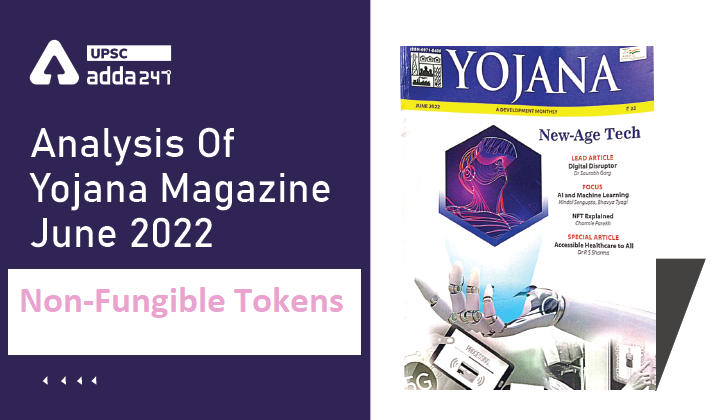Table of Contents
Yojana Magazine is a very important and indispensable source for UPSC Civil Services Exam Preparation. Here, we come with ”Analysis Of Yojana Magazine” which covers the monthly Yojana Magazine keeping in mind the demand of UPSC, particularly from the topics of important government schemes.
In ‘‘Analysis Of Yojana Magazine,” we cover each and every topic of the Yojana edition of a particular month and provide an easy-to-understand gist.
This topic-wise analysis is prepared from June 2022 edition of the monthly Yojana Magazine.
Introduction
- NFT(Non-fungible tokens) is a technology that allows creators and artists to bypass intermediaries altogether
- Non-fungible tokens (NFTs), a type of digital asset, have exploded in popularity these days, with NFT artworks selling for millions of dollars.
- With the invention of NFT, decentralisation has taken place and has allowed artists and creators to gain control – not just over the financial value of their artworks but also over the ownership and copyright of the same.
What is an NFT?
- An NFT is a digital asset that exists on a blockchain. The blockchain serves as a public ledger, allowing anyone to verify the asset’s authenticity and ownership.
- So unlike most digital items which can be endlessly reproduced, each NFT has a unique digital signature, meaning it is one of a kind.
- NFTs are usually bought with the cryptocurrency Ether or in dollars and the blockchain keeps a record of transactions.
- While anyone can view the NFTs, the buyer has the status of being the official owner – a kind of digital bragging rights.
What Kind Of NFTs Exist?
- All kinds of digital objects – images, videos, music, text and even tweets – can be turned into an NFT.
- Digital art has seen some high-profile sales, while in sports, fans can collect and trade NFTs relating to a particular player or team.
- NFTs can also be patches of land in virtual world environments, or exclusive use of a cryptocurrency wallet name.
When NFT started?
- Started with a set of 10000 randomly generated pixelated images that proved the demand for digital ownership of non-physical objects and collections in 2017, and the market has been evolving ever since.
Why NFT Now?
- Some attribute it to lockdowns forcing people to spend more time at home on the internet.
- But NFTs are also a way to have possessions that can be viewed by owners’ online friends.
- For others, the lure lies in rapidly rising prices and the prospect of big returns.
- Recent years have also created a lot of crypto millionaires with Ethereum to spend.
Who controls NFT?
- NFTs are based on the decentralised cryptocurrencies where the control does not remain with any financial institution constituted by the government but is purely driven by market forces and volition of the people or computers connected in a Blockchain Network.
Why are NFTs Important?
- Enthusiasts see NFTs as the future of ownership. All kinds of property – from event tickets to houses – will eventually have their ownership status tokenised in this way, they believe.
- For artists, NFTs could solve the problem of how they can monetise digital artworks. They can receive more income from NFTs, as they can get a royalty each time the NFT changes hands after the initial sale.
- NFTs could also transform music.
What are the Risks?
- Given that anybody can create NFTs, the scarcity of each piece does not guarantee value. Losses can stack up if the hype dies down.
- In a market where many participants use pseudonyms, fraud is also a risk.



 TSPSC Group 1 Question Paper 2024, Downl...
TSPSC Group 1 Question Paper 2024, Downl...
 TSPSC Group 1 Answer key 2024 Out, Downl...
TSPSC Group 1 Answer key 2024 Out, Downl...
 UPSC Prelims 2024 Question Paper, Downlo...
UPSC Prelims 2024 Question Paper, Downlo...




